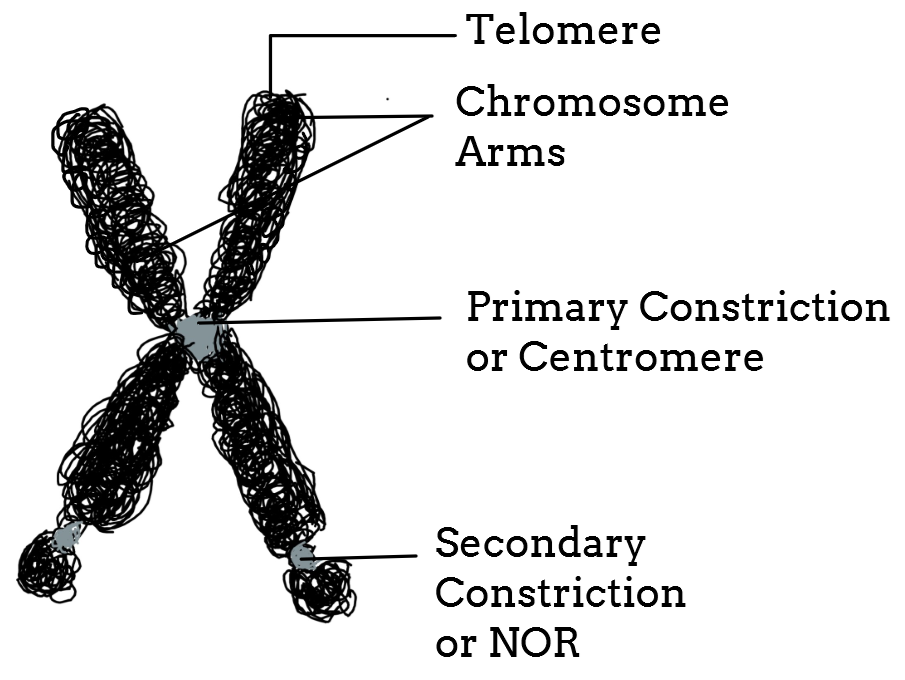
Describe the structure of the chromosome with a suitable diagram.
Answer
558k+ views
Hint: It is a form of DNA that is highly condensed and contains the genome of the organism. In a human's diploid somatic cell there exist 23 pairs (46) of chromosomes in which there are 44 autosomes (22 pairs) and 2 allosomes or sex chromosomes (1 pair) which in males is XY and XX in females.
Complete Step by Step Answer:
A chromosome is a highly coiled structure formed due to the condensation of chromatin fibers. The occurrence of one set of chromosomes implies a haploid condition and two sets of chromosomes imply a diploid condition. The chromosome mainly consists of DNA, the main genetic material which is tightly coiled many times around the protein histone that supports its structure.

- A chromosome is differentiated into three parts:
Pellicle: it is a very thin outer envelope.
Matrix: The ground substance made up of non- genic materials, also contains chromonemata.
Chromonemata: it is deeply embedded inside the matrix consisting of two spiral threads.
- A chromosome consists of the following parts:
Centromere: It is a small structure marked by a primary constriction in the center of the chromosome.
Chromatids: It is one of the two strands of a copied chromosome.
Telomere: These are specialized ends of the chromosome that exhibits physiological differentiation.
NOR: Nucleolus organizing region also called secondary constriction accounts for the formation of the nucleolus.
- Based on the position of the centromere chromosomes are divided into four categories:
Metacentric: When the centromere is present in the middle of the chromosomes and forms two equal arms it is called metacentric chromosomes.
Sub-metacentric: When the centromere is present slightly away from the middle of the chromosomes is called sub-metacentric chromosomes.
Acrocentric: When the centromere is present close to the end of the chromosomes it is called acrocentric chromosomes.
Telocentric: When the centromere is present at the terminal of the chromosomes is called telocentric chromosomes.
Note: Sometimes a few chromosomes have a non- staining secondary constriction at the same location. This gives the appearance of a small fragment called the satellite. The word chromosome was derived from the Greek word chroma, meaning "color" and soma, meaning "body". They are aware of the strong staining of a particular dye. The term chromosome was coined by the German scientist von Waldeyer-Hartz. Walther Flemming was the scientist who named the term chromatin and also discovered the cell division.
Complete Step by Step Answer:
A chromosome is a highly coiled structure formed due to the condensation of chromatin fibers. The occurrence of one set of chromosomes implies a haploid condition and two sets of chromosomes imply a diploid condition. The chromosome mainly consists of DNA, the main genetic material which is tightly coiled many times around the protein histone that supports its structure.

- A chromosome is differentiated into three parts:
Pellicle: it is a very thin outer envelope.
Matrix: The ground substance made up of non- genic materials, also contains chromonemata.
Chromonemata: it is deeply embedded inside the matrix consisting of two spiral threads.
- A chromosome consists of the following parts:
Centromere: It is a small structure marked by a primary constriction in the center of the chromosome.
Chromatids: It is one of the two strands of a copied chromosome.
Telomere: These are specialized ends of the chromosome that exhibits physiological differentiation.
NOR: Nucleolus organizing region also called secondary constriction accounts for the formation of the nucleolus.
- Based on the position of the centromere chromosomes are divided into four categories:
Metacentric: When the centromere is present in the middle of the chromosomes and forms two equal arms it is called metacentric chromosomes.
Sub-metacentric: When the centromere is present slightly away from the middle of the chromosomes is called sub-metacentric chromosomes.
Acrocentric: When the centromere is present close to the end of the chromosomes it is called acrocentric chromosomes.
Telocentric: When the centromere is present at the terminal of the chromosomes is called telocentric chromosomes.
Note: Sometimes a few chromosomes have a non- staining secondary constriction at the same location. This gives the appearance of a small fragment called the satellite. The word chromosome was derived from the Greek word chroma, meaning "color" and soma, meaning "body". They are aware of the strong staining of a particular dye. The term chromosome was coined by the German scientist von Waldeyer-Hartz. Walther Flemming was the scientist who named the term chromatin and also discovered the cell division.
Recently Updated Pages
Master Class 11 Social Science: Engaging Questions & Answers for Success

Master Class 11 Physics: Engaging Questions & Answers for Success

Master Class 11 Maths: Engaging Questions & Answers for Success

Master Class 11 Economics: Engaging Questions & Answers for Success

Master Class 11 Computer Science: Engaging Questions & Answers for Success

Master Class 11 Chemistry: Engaging Questions & Answers for Success

Trending doubts
What is meant by exothermic and endothermic reactions class 11 chemistry CBSE

10 examples of friction in our daily life

Difference Between Prokaryotic Cells and Eukaryotic Cells

1 Quintal is equal to a 110 kg b 10 kg c 100kg d 1000 class 11 physics CBSE

One Metric ton is equal to kg A 10000 B 1000 C 100 class 11 physics CBSE

Draw a diagram of a plant cell and label at least eight class 11 biology CBSE




